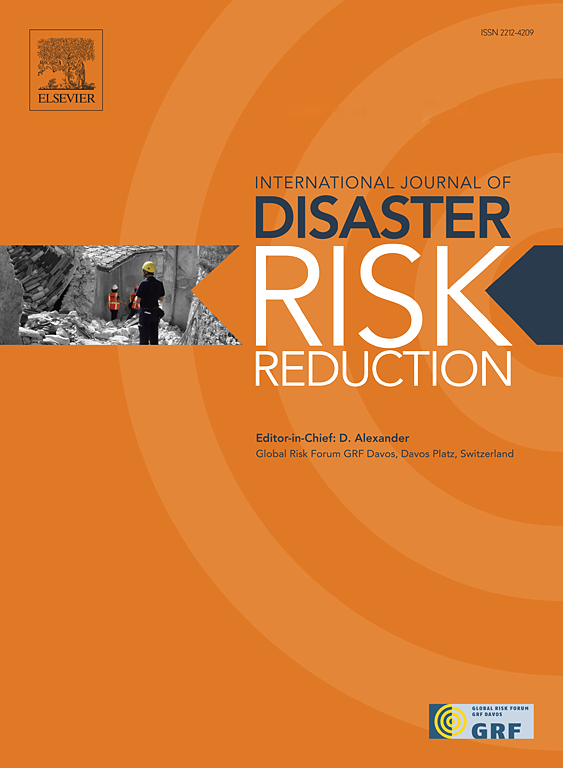瑞士洪水风险监测:概念验证
IF 4.5
1区 地球科学
Q1 GEOSCIENCES, MULTIDISCIPLINARY
International journal of disaster risk reduction
Pub Date : 2025-03-01
DOI:10.1016/j.ijdrr.2025.105337
引用次数: 0
摘要
洪水风险的时空演变是洪水风险管理面临的挑战。气候变化、土地利用变化、人类干预和社会经济发展导致了主要风险成分(危害、暴露和脆弱性)的动态变化。这些动态需要不断调整风险管理策略,以确保人类及其资产的长期安全水平。为了实现适应性洪水风险管理,有必要监测风险演变。风险监测可以更好地了解风险演变,识别时空差异,并检测特定地点的变化驱动因素。然而,洪水风险监测的概念和应用还比较缺乏。在这项研究中,我们使用一个国家案例研究(瑞士)评估了洪水风险监测的应用,该案例研究收集了10年的数据。不断更新的灾害地图、潜在危险地区的房屋数量和受损程度被用来量化洪水对建筑物的潜在破坏程度的演变。结果表明,瑞士和不同行政区域洪水风险的年际演变存在差异,洪水风险演变的空间变异性以及洪水风险成分演变的变异性。2014年至2023年间,瑞士的总洪水风险增加了26%,灾害面积增加了32%,暴露程度增加了35%。风险因素的分离可以更好地理解增加或减少风险的重要驱动因素。然而,数据的可用性和一致性是洪水风险监测面临的挑战。本文章由计算机程序翻译,如有差异,请以英文原文为准。
Flood risk monitoring in Switzerland: Proof of concept
The spatiotemporal evolution of flood risk is a challenge for flood risk management. Climate change, land-use change, human intervention, and socio-economic development lead to dynamics in the main risk components - hazard, exposure, and vulnerability. These dynamics require continuous adaptation of risk management strategies to ensure the safety level of humans and their assets in the long term. To enable adaptive flood risk management, it is necessary to monitor the risk evolution. Risk monitoring provides a better understanding of the risk evolution, identifies spatiotemporal differences, and detects location-specific drivers of change. However, flood risk monitoring concepts and their application are lacking. In this study, we evaluate the application of flood risk monitoring using a national case study (Switzerland) with data collected over a time period of 10 years. The continuously updated hazard maps, the number of houses in potentially endangered areas and the degree of damage are used to quantify the evolution of flood risk in terms of potential damage to buildings. The results show varying annual evolution of the flood risk in Switzerland and in different administrative units, the spatial variability of the flood risk evolution, and the variability in the evolution of the flood risk components. Between 2014 and 2023, the total flood risk in Switzerland increased by 26 %, the hazard area increased by 32 % and the exposure by 35 %. The disentangling of risk factors allows a better understanding of important drivers that increase or decrease risk. However, data availability and consistency are challenges for flood risk monitoring.
求助全文
通过发布文献求助,成功后即可免费获取论文全文。
去求助
来源期刊

International journal of disaster risk reduction
GEOSCIENCES, MULTIDISCIPLINARYMETEOROLOGY-METEOROLOGY & ATMOSPHERIC SCIENCES
CiteScore
8.70
自引率
18.00%
发文量
688
审稿时长
79 days
期刊介绍:
The International Journal of Disaster Risk Reduction (IJDRR) is the journal for researchers, policymakers and practitioners across diverse disciplines: earth sciences and their implications; environmental sciences; engineering; urban studies; geography; and the social sciences. IJDRR publishes fundamental and applied research, critical reviews, policy papers and case studies with a particular focus on multi-disciplinary research that aims to reduce the impact of natural, technological, social and intentional disasters. IJDRR stimulates exchange of ideas and knowledge transfer on disaster research, mitigation, adaptation, prevention and risk reduction at all geographical scales: local, national and international.
Key topics:-
-multifaceted disaster and cascading disasters
-the development of disaster risk reduction strategies and techniques
-discussion and development of effective warning and educational systems for risk management at all levels
-disasters associated with climate change
-vulnerability analysis and vulnerability trends
-emerging risks
-resilience against disasters.
The journal particularly encourages papers that approach risk from a multi-disciplinary perspective.
 求助内容:
求助内容: 应助结果提醒方式:
应助结果提醒方式:


